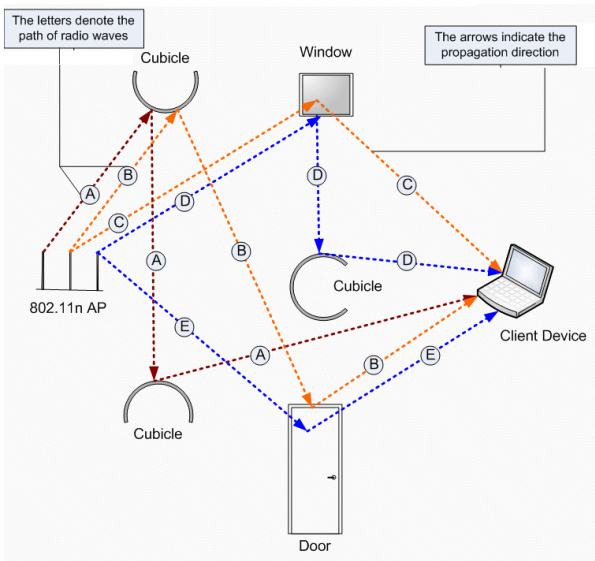Wireless APs use MIMO (multiple input, multiple output) — a technology that uses advanced signal processing with multiple antennas to improve throughput. MIMO takes advantage of multipath propagation to decrease packet retries to improve the fidelity of the wireless network. MIMO increases throughput by using multiple streams.
MIMO radios send out one, two or three radio signals through each antenna. Each signal is called a spatial stream. The antennas on the AP are deliberately spaced so that each spatial stream follows a slightly different path to the client device. Two spatial streams get multiplied into several streams as they bounce off obstructions in the vicinity. This phenomenon is called multipath. As the streams are bounced from different surfaces, they follow different paths to the client device. The client device also has multiple antennas. Each of the antennas independently decodes the arriving signal. Then the decoded signal from each antenna combines with the decoded signals from the other antennas. A software algorithm uses this redundancy to extract one or two spatial streams and enhances the signal to noise ratio of the streams.
The client device also sends out one or two spatial streams through its multiple antennas. These spatial streams get multiplied into several steams as they bounce off the obstructions in the vicinity en route to the AP. MIMO receivers receive these multiple streams with three antennas. Each of the three antennas independently decodes the arriving signal. Then the decoded signal of each antennas is combined with the decoded signals from the other antennas. The receiving AP's MIMO receiver also uses redundancy to extract one or two spatial streams and enhances the streams' signal to noise ratio.

Operating with multiple antennas, an AP with MIMO is capable of picking up even the weakest signals from the client devices.
The AP39xx models offer Multi-User MIMO that enables Wave2 APs to communicate with multiple Wave2 clients concurrently, in the downstream direction. Up to 3 MU-MIMO conversations concurrently.

 Print
this page
Print
this page Email this topic
Email this topic Feedback
Feedback